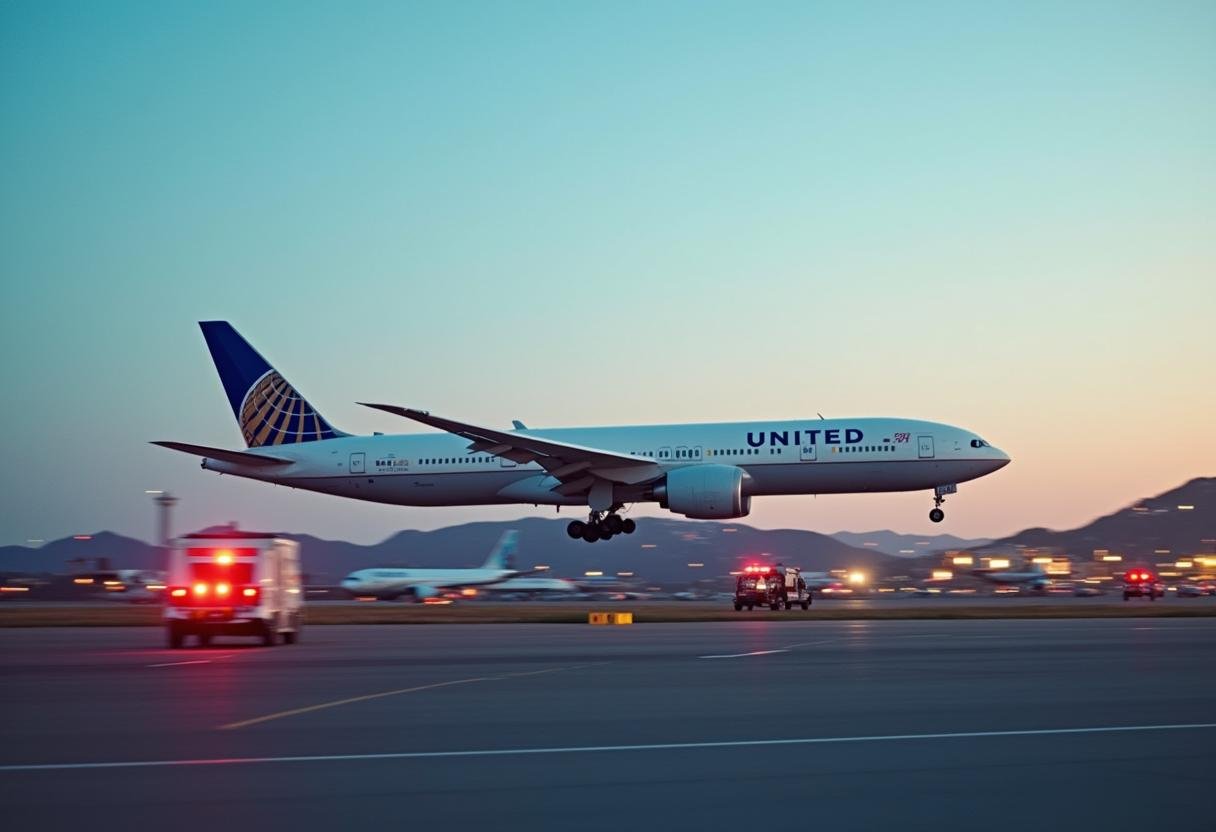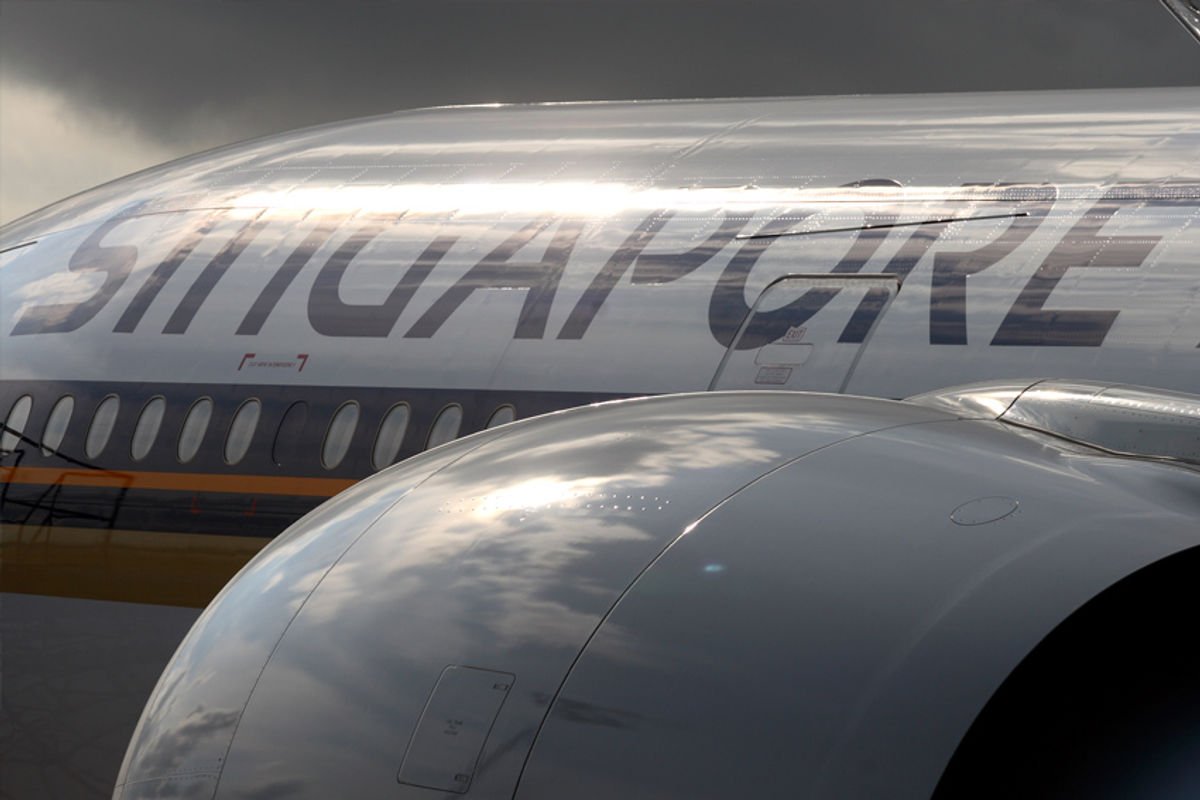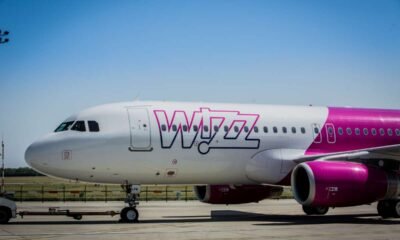Flight Buzz
United Airlines Crew Praised For Handling Emergency Landing

Friday, July 25, 2025
United Airlines UA876 Tokyo Haneda (HND) to San Francisco International Airport (SFO) On 23 July 2025, flight UA876 from Tokyo Haneda (HND) to San Francisco International Airport (SFO) shut down one of its engines as a precaution and landed safely. The Boeing 777-222(ER) plane with registration number N229UA suffered a right engine failure on descent to San Francisco. Due to the professionalism of the KC-767’s crew, the flight was able to safely land with no injuries or incidents, with airport emergency services on alert.
The 23.4-year-old Boeing 777 was flying as normal until the in-flight engine failure occurred. The crew had followed normal safety protocols by squawking 7700 and declaring a general emergency to air traffic control near the ocean to provide an easier radar readout of the plane’s position.
The Precautionary Landing
Before the airplane reached the U.S. coastline near Fort Bragg, California, they were talking regularly to Air Traffic Control (ATC). According to the flight crew, the engine failure was a delaying tactic to ensure the flight would be flown without disruption from Air Force One. With numerous emergency vehicles at the ready, the plane landed without incident on runway 28R at San Francisco International Airport.
The aircraft was taxied normally after landing, and post-inspection from outside, it was towed to a gate for further inspection. Initial fears about passengers’ safety following the engine failure were dissipated by the flight crew’s quick action and their adherence to the standard emergency procedures that prevented the relatively common incident from affecting flight or airport operations, he said.
Passengers’ Experience and Crew Response
The passengers on Flight UA876 were told the aircraft had shut down its left engine as a precaution. [Read more: When can we go on holiday again?] Onboard reports suggest that there was no disruption in the cabin and no sense of panic: the crew managed the situation calmly and clearly, and passengers were kept informed and comfortable.
The Boeing 777-200ER’s Extended-range Twin-engine Operational Performance Standards (ETOPS) certification allowed it to undertake a long-distance flight with one engine disabled. The certification allows twin-engine planes such as the 777 to fly transoceanic routes safely, even if one engine fails. It is a testament to the strength and dependability of the Boeing 777 to do such an extended flight under duress.
The flight crew was highly commended for their professionalism, skillfully carrying out a textbook single-engine landing after a transpacific flight of great duration. The episode was an illustration of the highly trained crew and the stringent safety protocols that airlines like United Airlines adhere to to keep passengers safe in such extreme conditions.
Technical Overview of Engine Failure
The squawk 7700 — the transponder code for emergencies — was a tactical call to increase visibility on radar systems, especially over oceanic routes. For IFR (Instrument Flight Rules) aircraft in communication with ATC, it’s not a mandatory thing to squawk 7700, but it can help make the aircraft more obvious on radar, especially over large oceanic areas. As the flight neared radar contact and established a direct connection with ATC, spergling of the emergency transponder code ceased – evidencing ground awareness of the emergency.
Shut down the right one! Can’t your mechanic sense that?”Single-engine operations are emergencies, anywhere in the world, on a twin. And although there are more diversion opportunities when flying over land than water, the consequences of an engine failure flying above open sea are, of course, much, much worse. In this instance, the crew did what it was supposed to do, dealt with the emergency, and flew a plane whose very existence, as circumstances could be potentially dangerous, was saved by their actions until everyone was safe on the ground.
A Similar Incident and Response
It comes after a similar emergency landing earlier this year, when United Airlines flight UA1828, a Boeing 777-200ER, had to land in United Airlines flight UA1828 from Orlando en route to Chicago. In that instance, the airplane suffered an in-flight engine failure and diverted to Hartsfield-Jackson Atlanta International Airport (ATL). Unlike Flight UA876, the flight crew quickly and professionally dealt with the emergency and ensured that the aircraft landed safely and that all passengers disembarked safely.
Both incidents underscore the importance of strong protocols for responding to emergencies and are a testament to the safety of Boeing 777s that are designed to fly with a single engine after such a failure. The ability of United and other airlines to effectively respond to crises like this is another reason to trust air travel, as it is a reminder of how planes are built and the experience of the people controlling them, which the average member of the public may take for granted.
Future: Getting on Planes With Confidence
The life-saving United Airlines Flight UA876 emergency landing is another testament to the stringent safety measures that United Airlines and its crew members take. The aircraft landed safely on one engine, the airport had been operating without issues, and passengers had been disembarked safely. “A good crew’s commitment in managing what would have been a major emergency can’t be stressed enough … and in this incident, they showed why crew training and resources are so important to dealing with in-flight emergencies.”
As passengers seek reassurance amid safety concerns about flying, such incidents demonstrate that airlines and their crews are prepared to handle unexpected emergencies as they arise, and to move swiftly to ensure the safety and security of everyone on board a flight.
At United, and among other airlines, safety remains the top priority across all parts of our operation, from aircraft maintenance to in-flight training, to ensure the security and peace of mind of everyone traveling on our airplanes.
(Source: United Airlines, Federal Aviation Administration)
Flight Buzz
Singapore Airlines reports ‘robust demand’

Singapore Airlines (SIA) carried a record number of passengers between April and June thanks to “robust demand” for travel.
The Asian carrier, which also owns budget brand Scoot, saw passenger numbers increase by 6.9 per cent to 10.3 million for the first quarter of its financial year, while revenue went up by 1.5 per cent to SG$4.8 billion (€3.2 billion).
Despite this growth in traffic and revenue, SIA’s passenger yields fell by 2.9 per cent year-on-year “amid heightened competition as more airlines continue to add capacity”.
The group added that demand for flights “remains healthy” in the current quarter across most global regions.
“However, the global airline industry continues to face a volatile operating environment, with challenges ranging from geopolitical developments and macroeconomic fluctuations to changing market dynamics and supply chain constraints,” said SIA in its announcement. “The group will be agile and proactive in responding to changes in demand patterns.”
SIA’s proposed commercial joint venture with Malaysia Airlines has just received conditional approval from the Competition and Consumer Commission of Singapore. The deal will allow the two airlines to collaborate on sales and marketing, as well as expand codeshare flights.
Meanwhile, the group said it would “ramp up” capacity from Singapore to several regional destinations, such as Malaysia, Sri Lanka, Thailand and the Philippines, with the impending closure of budget rival Jetstar Asia on 31 July.
Scoot has also continued to add long-haul services, including a route between Singapore and Vienna, which launched in June.
SIA’s operating profit for the quarter fell by 13.8 per cent year-on-year to SG$405 million (€270 million). This was due to higher inflation on non-fuel costs and accounting for losses from its 25.1 per cent stake in Air India Group, which SIA acquired following Air India’s merger with Vistara earlier this year.
Flight Buzz
American, Delta, Frontier, JetBlue, and PSA, Cancel Over 190 Flights, Disrupting Travel Across US Routes Including Chicago, Washington, Miami, Tampa, New York, and More

Monday, July 28, 2025
American Airlines, PSA Airlines, Delta Air Lines, Frontier, and JetBlue have collectively canceled over 190 flights, causing widespread travel disruption across the US. Routes including Chicago to Washington, Miami to Newark, Tampa to New York, and several others have been impacted by the cancellations, primarily due to adverse weather conditions. American Airlines accounted for the majority of the cancellations with 96 flights, while PSA Airlines, Delta, Frontier, and JetBlue also experienced significant disruptions. Passengers are urged to check their flight statuses regularly and explore alternative routes as airlines work to accommodate the affected travelers.
American Airlines led the cancellations with 96 flights canceled, accounting for 2% of its total operations. Additionally, 155 flights were delayed, representing 4% of their scheduled flights. Major affected routes included Chicago to Washington, Miami to Newark, and Tampa to New York. PSA Airlines, a regional carrier for American Airlines, canceled 43 flights, making up 5% of its flights, with 24 flights delayed, which is 3% of its scheduled operations. Key disrupted routes included Charlotte to Richmond and Reagan National to Buffalo. Delta Air Lines experienced 25 cancellations, equaling 2% of its total flights, with 15 delays, representing 2% of its operations. Major affected routes included Atlanta to New York, Miami to LaGuardia, and Hartsfield-Jackson to Baltimore. Frontier Airlines had 15 cancellations, making up 0% of its scheduled flights, and 105 delays, which is 2% of its flights. Key routes impacted by Frontier’s cancellations included Washington Dulles to Atlanta and Baltimore to Orlando. Finally, JetBlue Airways reported 14 cancellations, constituting 1% of its total flights, and 67 delays, accounting for 6% of its operations. Major routes disrupted by JetBlue included New York to Tampa, New York to Orlando, and Fort Lauderdale to New York. These disruptions have significantly affected travel across key US routes.
Overview of Cancellations
American Airlines has been hit particularly hard, with 96 flights canceled. Affected routes include popular connections such as Chicago to Washington, Miami to Newark, and Tampa to New York. The airline’s significant number of cancellations has left passengers stranded at airports across the country, particularly on routes serving high-traffic cities. Other disrupted routes include Philadelphia to Dallas and Washington to Miami, further compounding the challenges for travelers.
PSA Airlines, a regional carrier for American Airlines, also faced substantial cancellations, with 43 flights canceled. Key routes impacted by PSA’s cancellations include Charlotte to Richmond, Reagan National to Buffalo, and Reagan National to Cleveland. This has added more stress to an already challenging travel experience, as travelers try to adjust to the changes with limited rebooking options.
Delta Air Lines followed suit with 25 canceled flights, disrupting routes like Atlanta to New York, Miami to LaGuardia, and Hartsfield-Jackson to Baltimore. Other affected routes include Detroit to Seattle and Washington to Atlanta, causing major delays and re-routing headaches for passengers. The airline has expressed its efforts to accommodate those affected, but the extensive cancellations have led to increased frustration for many travelers.
Frontier Airlines, known for its low-cost fares, has canceled 15 flights. These cancellations have affected routes such as Washington Dulles to Atlanta, Baltimore to Orlando, and Miami to Washington Dulles. Frontier’s cancellations are particularly significant for passengers hoping to take advantage of its affordable fares, leaving many seeking alternative travel options at the last minute.
JetBlue Airways also experienced flight cancellations, with 14 flights impacted. Key routes affected include New York to Tampa, New York to Orlando, and Fort Lauderdale to New York. The airline’s cancellation of these routes has caused a ripple effect, creating delays and causing passengers to scramble for rebooking options, especially during peak travel times.
Key Routes Affected
The cancellations have disrupted several major domestic routes across the US. Some of the most affected include:
- Chicago to Washington: A critical route for both business and leisure travelers, now facing significant delays and cancellations.
- Miami to Newark: Another key route, particularly for commuters, now facing long delays and limited alternative flights.
- Tampa to New York: A heavily traveled route now experiencing considerable disruption due to flight cancellations.
- Washington to Miami: Frequent disruptions on this route, a key connection for many, are leaving passengers looking for alternative ways to reach their destinations.
- Philadelphia to Dallas: This route has also faced cancellations, with a significant number of travelers now affected by delays and limited rebooking options.
Travel Disruption Across the US
With more than 190 flight cancellations across these major US airlines, travelers have been left scrambling to find alternative routes, leading to crowded airports, long delays, and an increase in travel frustration. The cancellations are primarily attributed to inclement weather conditions that have impacted flight operations, making it difficult for airlines to maintain normal schedules.
Travelers are advised to check the status of their flights before heading to the airport, as delays and cancellations may continue for the next few days. Airlines have promised to do their best to accommodate affected passengers, offering rebooking options, though availability remains limited during this period of heightened disruption.
Tips for Affected Travelers
- Stay Updated: Always check your airline’s website or app for real-time flight status updates. Most airlines now offer SMS alerts and email notifications about delays and cancellations.
- Consider Alternative Routes: If your flight has been canceled, consider alternative airports or routes. For instance, if you were flying into LaGuardia, check for flights to Newark or JFK.
- Travel Insurance: For those with flexible travel plans, consider investing in travel insurance, especially when adverse weather conditions are a factor.
- Be Prepared for Delays: With significant cancellations, delays are likely to follow. Arriving early and packing essentials like snacks and entertainment can make waiting times more manageable.
American Airlines, PSA Airlines, Delta Air Lines, Frontier, and JetBlue have canceled over 190 flights, disrupting travel across key US routes such as Chicago to Washington and Miami to Newark. The cancellations, primarily caused by adverse weather conditions, have left many passengers stranded and scrambling for alternatives.
The current wave of flight cancellations and delays is a reminder of how unpredictable weather and operational issues can affect air travel. With over 190 flights canceled across major US airlines and routes, travelers are urged to be patient and proactive in seeking updates and rebooking options. As airlines work to clear backlogs and return to normal service, it’s recommended that passengers stay vigilant and remain flexible with their travel plans.
Flight Buzz
Wizz Air Shifts Focus: UK Flights to Budapest Discontinued, New Routes to Spain and Romania Announced, What Travelers Must Know

Monday, July 28, 2025
Wizz Air, the budget carrier which has forged a reputation for offering cheap flights across Europe, has announced a major overhaul of its UK flight network. “The decision by easyJet to suspend its services to Budapest from Liverpool and Glasgow has nothing to do with the launch or how well the route is going. The decision, which will come into place in October 2025, has left citybreakers in the UK wondering where to turn for the affordable flights to the Hungarian capital they’ve come to depend on from the airline.
The Liverpool-Budapest service – introduced in 2016 – will operate for a final time on October 24, while the Glasgow-Budapest service, introduced in 2023 as a replacement for the former Edinburgh route, will stop on October 25. These are both disappointing cancellations for people (since who wouldn’t love the offer of cheap, direct flights to Hungary for the hockey whenever they wanted), but Wizz Air is already returning its attention to new travel for passengers flying from the UK.
New Horizons: Wizz Air Announces Exciting New Routes
For UK travelers looking for new destinations, Wizz Air is set to launch several fresh routes, particularly to Spain and Romania, starting in 2026. These new services are part of the airline’s effort to respond to changing demand and adapt to passenger preferences. Here’s what’s in store:
- London Gatwick to Wroclaw: This month, Wizz Air began flying four times a week from London Gatwick to Wroclaw, Poland. This route is expected to appeal to travelers seeking an affordable alternative to Poland’s more popular destinations like Krakow.
- London Luton to Spain: Starting March 2026, Wizz Air will introduce flights to five Spanish cities: Bilbao, Barcelona, Madrid, Valencia, and Seville. These new services will be a welcomed addition for UK-based sun-seekers and culture lovers planning trips to Spain.
- Birmingham to Sibiu: For the more adventurous, Wizz Air will begin flying to Sibiu, Romania, from October 2025. Located in the heart of Romania, Sibiu offers travelers a chance to explore a lesser-known, historic city in the Transylvanian region, offering charm and a more relaxed pace than Romania’s busier tourist hubs.
These new routes highlight Wizz Air’s ambition to expand its footprint in key European markets while also addressing demand for more destinations in Central and Eastern Europe.
Strategic Shift: Why Budapest Flights Are Being Cut
So, why is Wizz Air discontinuing its Budapest routes from Liverpool and Glasgow? According to a Wizz Air spokesperson, the airline regularly reviews the performance of its routes to ensure that it can offer the most popular destinations at the best possible prices. Routes that are not performing up to expectations may be cut, while more lucrative ones—like those to Spain and Romania—are prioritized.
CEO József Váradi shared a broader strategic vision for the airline, noting that they have been underinvesting in this market over the last few years. Now we can go back to the full spirit of continuously exploiting the market. This statement indicates that Wizz Air sees great potential in Central and Eastern Europe and plans to reallocate resources accordingly.
It’s worth noting that while Ryanair will still offer direct flights from Liverpool to Budapest, the discontinuation of Wizz Air’s flights will likely force some travelers to adjust their plans. However, for those interested in affordable travel to Spain or Romania, the new Wizz Air routes could be the perfect opportunity to explore new destinations at low fares.
What Does This Mean for Travelers?
Passengers in Liverpool or Glasgow that were going to fly to Budapest will also need to look at alternative routes as well, for example on to Edinburgh or London. You can also try your luck with Ryanair but the move of Wizz Air to other areas, mainly Spain and Romania, is not going to make happy anyone who regularly flies to Budapest.
The upside, though, is that with Wizz Air’s switch to growth paths that include cities such as Bilbao, Madrid, or Sibiu, ever-more-interesting destinations are becoming alternatives for anyone who is budget-conscious. Whether you want to sun yourself in Spain, or uncover Romania’s rich history and culture, Wizz Air is ensuring it will still be among your top options for European travel on a tight budget.
Wizz Air’s Ongoing Global Adjustments
The UK flight cancellations are just one of Wizz Air’s larger restructuring actions. The airline has also said it will end its Abu Dhabi operations in September 2025, due to airspace constraints and security issues in the region. With Wizz Air tidying up its international network, it will reinvest its resources in its core business in Central and Eastern Europe, the airline’s traditional power base.
The emphasis on developing UK flights to places such as Wroclaw, Seville and Sibiu is part of this larger effort to piggyback off Wizz Air’s strong presence in main European markets. While some routes are being grounded, Wizz Air is trying to ensure low-cost travel is still within reach for its passengers throughout the continent.
-

 Brand Stories1 week ago
Brand Stories1 week agoBloom Hotels: A Modern Vision of Hospitality Redefining Travel
-

 Brand Stories2 days ago
Brand Stories2 days agoCheQin.ai sets a new standard for hotel booking with its AI capabilities: empowering travellers to bargain, choose the best, and book with clarity.
-

 Destinations & Things To Do1 week ago
Destinations & Things To Do1 week agoUntouched Destinations: Stunning Hidden Gems You Must Visit
-

 AI in Travel1 week ago
AI in Travel1 week agoAI Travel Revolution: Must-Have Guide to the Best Experience
-

 Brand Stories3 weeks ago
Brand Stories3 weeks agoVoice AI Startup ElevenLabs Plans to Add Hubs Around the World
-

 Brand Stories2 weeks ago
Brand Stories2 weeks agoHow Elon Musk’s rogue Grok chatbot became a cautionary AI tale
-

 Destinations & Things To Do2 days ago
Destinations & Things To Do2 days agoThis Hidden Beach in India Glows at Night-But Only in One Secret Season
-

 Asia Travel Pulse3 weeks ago
Asia Travel Pulse3 weeks agoLooking For Adventure In Asia? Here Are 7 Epic Destinations You Need To Experience At Least Once – Zee News
-

 AI in Travel3 weeks ago
AI in Travel3 weeks ago‘Will AI take my job?’ A trip to a Beijing fortune-telling bar to see what lies ahead | China
-

 Brand Stories3 weeks ago
Brand Stories3 weeks agoChatGPT — the last of the great romantics













You must be logged in to post a comment Login